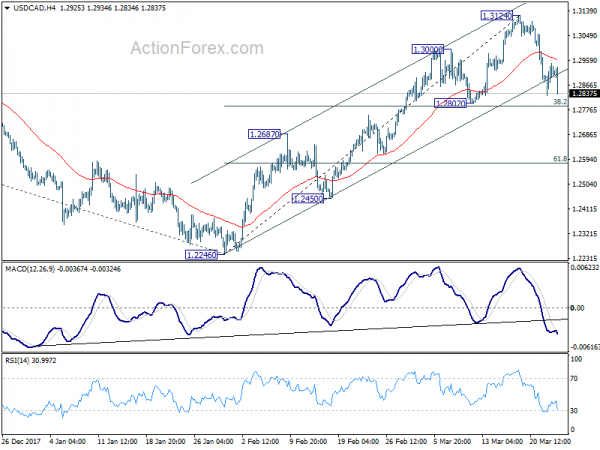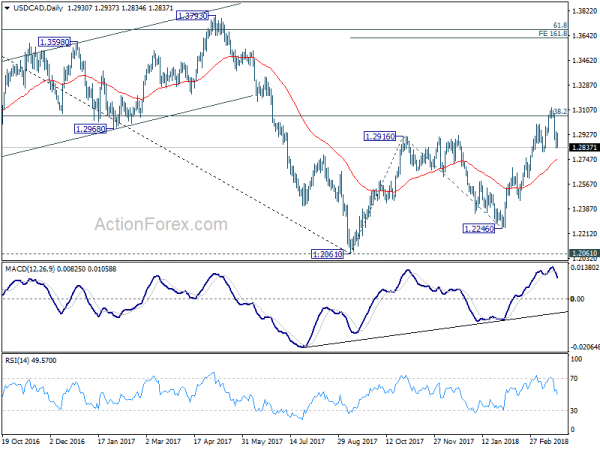After steep selloff in the Asian markets, sentiments stabilized mildly in European markets. At the time of writing, DAX is trading down -1.45%, CAC down -1.2 and FTSE down only -0.25%. US futures also point to a flat open, and stocks may recover from yesterday’s panic selloff. In the currency markets, Canadian Dollar is the strongest one for today as boosted by stronger than expected consumer inflation reading. It’s followed by Kiwi and Aussie as sentiments stabilized. Yen, on the other hand is paring back some gains. Meanwhile, Dollar continues to trade as the weakest one for the day, and the week, shrugging off solid durable goods orders.
Canada CPI gives CAD another lift
Canadian Dollar has been strong this week ever since the news that US dropped the toughest protectionist demand in NAFTA negotiations. Today’s stronger than expected inflation data gives the Loonie another lift. CPI rose 0.6% mom, 2.2% yoy in February, beat expectation of 0.5% mom, 2.0% yoy. Annual rate also accelerated from prior month’s 1.7% yoy. CPI core common accelerated to 1.9% yoy, up from 1.8% yoy. CPI core media rose to 2.1% yoy, up from 1.9% yoy. CPI core trimmed rose to 2.1% yoy, up from 1.8% yoy. retail sales was a disappointment but market shrugged that off. Canada retail sales rose 0.3% versus expectation of 1.2% mom in January. Ex-transport order, though, met expectation and rose 0.9% mom. Overall, recent developments are raising the chance of another BoC rate hike within the first half.
Fed Bostic: Fed at or near objectives, supports further rate hikes
Atlanta Fed President Raphael Bostic sounds upbeat in his prepared speech for Knoxville Economic Forum. With six month core inflation at 2%, and unemployment rate at 4.1%, he considered Fed is “at or near the sustainable employment and inflation objectives.” Regarding interest rate, he said that “if the economy evolves roughly as I suspect, I will likely support further increases over the course of the year.” And, “with the economy operating near its potential and inflation finally approaching the long-run target, it is appropriate, in my opinion, for monetary policy to be moving toward a more neutral stance.”
Released from US, durable goods orders rose 3.1% in February, above expectation of 1.7%. Ex-transport orders rose 1.2% versus expectation of 0.5%.
Following yesterday’s Section 301 tariffs targeted at China, US announced temporary suspension on some countries for the steel and aluminum tariffs. In short, the countries that are temporarily exempted include Argentina, Australia, Brazil, Canada, Mexico, EU and South Korea. They added up to 52.7% of US steel import in 2017. But two of US closest allies, Japan and Taiwan, are not in the exemption list.
China responds to US section 301 tariffs: Don’t drag trade relations to a dangerous place
There are two responses from China today regarding recent protectionist trade measures by the US. Firstly, China’s Ministry of Commerce announced measures countering the steel and aluminum tariffs. The MOFCOM proposed a list of 128 US imports with total value at over USD 3b in 2017. A 15% tariff will be imposed on the first group including wines, fresh fruit, dried fruit and nuts, steel pipes, modified ethanol, and ginseng. Then a 25% tariff could be imposed on the second group, including pork and recycled aluminium goods if both sides failed to reach a resolution through talks. China also said it could take legal action regarding the steel tariffs under WTO rules.
Secondly, China responded to the US Section 301 tariffs, targeted it, with a statement but without counter measures yet. The MOFCOM said it “doesn’t hope to be in a trade war, but is not afraid of engaging in one.” And, “China hopes the United States will pull back from the brink, make prudent decisions, and avoid dragging bilateral trade relations to a dangerous place.” An MOFCOM spokesperson also said “we firmly oppose” to the section 301 tariffs. He added that “it is a typical unilateral and protectionist practice.” And China is “fully prepared to firmly defend our interests.” And have “have confidence and capability in dealing with any challenges.” This is the response to the tariff on USD 50-60b) of China import.
Stiglitz to China: Don’t appease to bully Trump
Nobel prize-winning economist Joseph Stiglitz commented on the intensification of trade war between US an China. He pointed out that China is “sitting on $3 trillion of reserves that it can use to help those adversely affected. On the other hand, in the US, “we don’t have an economic framework that is able to respond to the particular places that will be affected by a trade war. Also, he pointed out that “the fiscal resources of the United States are strained.”
In addition, Stiglitz also said that “when you have a bully like Trump, it would not be good to respond in a weak way.” He added that “we know about appeasement from Munich. It’s a different kind of a war but in a trade war appeasement could lead to more and more demands.”
EU adopted Brexit negotiation guidelines
EU leaders formally approved the guidelines for the negotiation of future relations with the UK after Brexit in the EU summit today. Only a few minutes were taken for the approval. While symbolic, the approval now clears the way to move one to the next phase of Brexit negotiation. And the process will likely gain momentum from now on. Brexit negotiator Michel Barnier will now talk directly to the US about future relationship. The target is to reach a broad political agreement by October. The 7-page document can be found here.
UK Prime Minister Theresa May said that “I believe we are approaching this with a spirit of cooperation, a spirit of opportunity for the future as well, and we will now be sitting down and determining those workable solutions for Northern Ireland, but also for our future security partnership and economic partnership.” And, she added that “the best interest of both the UK and the EU that we get a deal that actually is in the interests of both.”
Japan CPI core hit 1% for the first time since 2014
Japan national CPI core accelerated to 1.0% yoy in February, up from 0.9% yoy and met expectation. That’s also the first time it hits 1% level since August 2014. The so called core-core CPI, CPI excluding fresh food and energy, rose to 0.5% yoy.
Newly appointed BoJ deputy governor Masazumi Wakatabe said in the parliament that the reading, especially the core-core CPI, showed that Japanese inflation expectation remain weak. He noted that “when compared to the United States or Europe, gains in Japan’s core-core CPI are insufficient.” He added that “what we can learn from this is that people still don’t believe inflation will reach 2 percent.” And, “inflation expectations are not anchored.” And he pledged to “maintain the regime and stance we have in place for monetary policy to meet 2 percent inflation and to strengthen it if possible.”
USD/CAD Mid-Day Outlook
Daily Pivots: (S1) 1.2863; (P) 1.2905; (R1) 1.2982; More….
USD/CAD drops sharply in early US session. But for the moment, it’s still staying above 1.2802 cluster support zone (38.2% retracement of 1.2246 to 1.3124 at 1.2789). Price actions from 1.3124 are viewed as a near term pull back only. And intraday bias stays neutral, and bullish outlook is unchanged. That is, further rally is expected. On the upside, break of 1.3124 will extend recent rally to 161.8% projection of 1.2061 to 1.2916 from 1.2246 at 1.3629 next. However, firm break of 1.2789/2802 will raise the chance of rejection by 1.3065 medium term fibonacci level and bring deeper fall to 55 day EMA (now at 1.2741).
In the bigger picture, we’re favoring the medium term bullish case. That is larger down trend from 1.4689 has completed at 1.2061 as a correction, drawing support from 50% retracement of 0.9406 (2011 low) to 1.4689 (2015 high) at 1.2048. Sustained break of 38.2% retracement of 1.4689 to 1.2061 at 1.3065 will pave the way to 61.8% retracement at 1.3685. This will be the preferred case now as long as 1.2802 support holds. However, rejection by 1.3065 will argue that price action from 1.2061 is merely a three wave corrective pattern. And 1.2061 will be put back into focus with medium term bearishness revived.
Economic Indicators Update
| GMT | Ccy | Events | Actual | Forecast | Previous | Revised |
|---|---|---|---|---|---|---|
| 23:30 | JPY | National CPI Core Y/Y Feb | 1.00% | 1.00% | 0.90% | |
| 12:00 | GBP | BoE Quarterly Bulletin | ||||
| 12:30 | CAD | CPI M/M Feb | 0.60% | 0.50% | 0.70% | |
| 12:30 | CAD | CPI Y/Y Feb | 2.20% | 2.00% | 1.70% | |
| 12:30 | CAD | CPI Core – Common Y/Y Feb | 1.90% | 1.90% | 1.80% | |
| 12:30 | CAD | CPI Core – Median Y/Y Feb | 2.10% | 1.90% | ||
| 12:30 | CAD | CPI Core – Trimmed Y/Y Feb | 2.10% | 1.80% | ||
| 12:30 | CAD | Retail Sales M/M Jan | 0.30% | 1.20% | -0.80% | -0.70% |
| 12:30 | CAD | Retail Sales Ex Auto M/M Jan | 0.90% | 0.90% | -1.80% | -1.70% |
| 12:30 | USD | Durable Goods Orders Feb P | 3.10% | 1.70% | -3.60% | |
| 12:30 | USD | Durables Ex Transportation Feb P | 1.20% | 0.50% | -0.30% | |
| 14:00 | USD | New Home Sales Feb | 621K | 593K |














